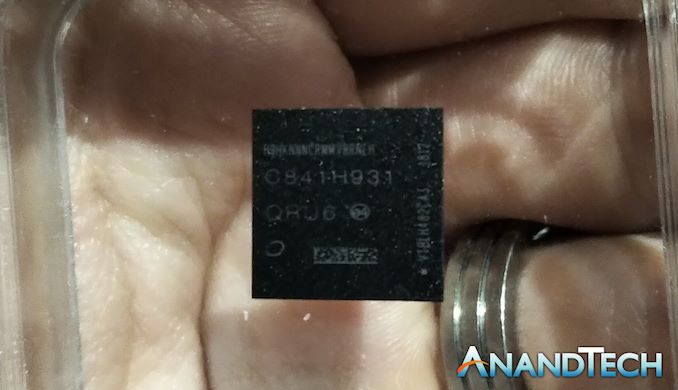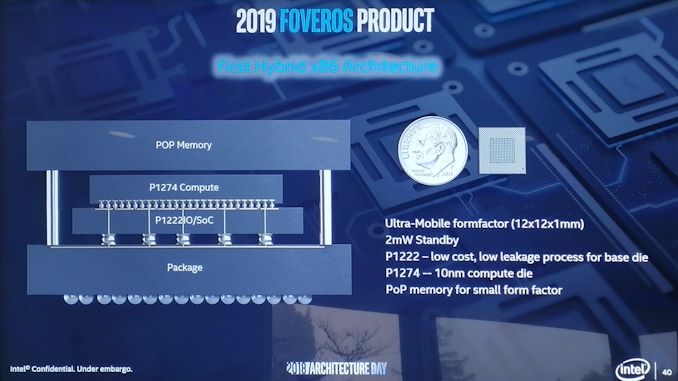Intel Hybrid CPU Starts 'End of Life' Process
by Dr. Ian Cutress on July 7, 2021 4:46 AM EST
As I opened my inbox this morning, I was surprised. I keep track of when Intel puts products on End of Life (or starts the process through something called Product Discontinuance), and so I usually see a run of 3-5 year old CPUs or storage or servers pass through without much of a worry. When I opened up my daily brief today however, the headline read ‘Core Processor with Hybrid Technology Discontinued’, which immediately struck me as a bit crazy.
Intel announced Lakefield, its only Hybrid CPU on the market, in January 2019. It pairs one of its big cores with four smaller Atom cores in a small 12mm square package. Not only this, Lakefield is one of Intel’s first Foveros packaging processors, with a 10nm compute piece of silicon sitting on top of an IO die, all packaged together with DRAM on top. The goal of the Lakefield design was to produce a processor with a super low idle power, but also have enough performance for hand-held devices. Intel quoted 1.2 mW when in idle, meeting that goal.
Lakefield came to market in June 2020 in two products: the Samsung Galaxy Book S 13.3-inch clamshell laptop, and the Lenovo ThinkPad X1 Fold, a foldable display-based design. Both of these products were premium priced, particularly the Fold with its display, however reported performance was more akin to a quad-core Atom notebook than the $2000 quad-core mobile devices they were aiming for. Battery life sounded good, although we have never tested it at AnandTech due to lack of access to review samples from Samsung, Lenovo, or Intel.
The key thing was the Hybrid CPU design. By pairing one of Intel’s big cores with four of its smaller Tremont Atom cores, the goal was to run the device almost exclusively on the Atom cores for efficiency and then call on the big core when anything latency related was required, such as when the user touches the screen or the keyboard. Within 16 milliseconds (or one frame at 60 Hz), the processor would switch over to the big core for the touch screen interaction, do what it needed to do (often in under 16 ms), and then power back down.
In principle, the concept is sound and makes a lot of sense, especially if the goal is to save battery. As Intel’s first Hybrid CPU design however, there were some initial teething issues as managing threads between the different performance levels required adjustments to Windows’ scheduler. Microsoft already has experience with this when dealing with Windows on Snapdragon devices using the Arm architecture, however it was a first for x86 and the first implementations were reportedly quite rough.
In reality, because of the price of the device, it was compared to hardware that had only big cores. Even if it was compared to Atom based notebooks in the $400 range, because the processor was a low powered device, often lower than the Atom notebooks it was being compared to, it didn’t fall favorably in those benchmarks either. The goal of Lakefield for Intel wasn’t performance, but experience and form factor innovation, which benchmarks never indicate.
The note today from Intel indicates that Lakefield is now on the path to End of Life. This means the following milestones:
- Start of Product Discontinuance: July 6th 2021
- Last Corporate Assurance: October 8th 2021
- Last Product Discontinuance Order: October 22nd 2021
- Orders are Non-Cancellable from October 22nd 2021
- Last Shipment Date: April 29th 2022
The start of the process means announcing that they will stop manufacturing processors (July 6th) and if a company wants to put in an order, they have until October 22nd. However that’s also the date where orders can’t be canceled or returned, and all orders will be shipped by April 29th. That means that products could still come out with Lakefield after April 29th, however the OEM partners will not have any means to secure additional stock.
Intel has set its sights on its future Hybrid CPU designs, with the upcoming Alder Lake platform set to launch end of this year in either desktops or notebooks. There is also talk that Windows 11 is better suited to deal with Intel’s hybrid designs from a scheduler perspective. Overall, to see its only public Hybrid CPU suddenly go on product discontinuance after only a year in the market isn’t a great commitment to the technology from OEM partners. Intel's own Product Change Notification states that 'market demand for the products listed has shifted to other Intel products'.
Related Reading
- The Intel Lakefield Deep Dive: Everything To Know About the First x86 Hybrid CPU
- Intel Discloses Lakefield CPUs Specifications: 64 Execution Units, up to 3.0 GHz, 7 W
- Samsung Unveils Intel-based Galaxy Book S: Intel’s Lakefield Inbound
- Lenovo’s ThinkPad X1 Fold: Combining Foldable Displays, 5G and Lakefield into a… Laptop?
- Intel: Lakefield in 2020, Possible 5G on Foveros
- Intel's new Atom Microarchitecture: The Tremont Core in Lakefield
- Hot Chips 31 Live Blogs: Intel Lakefield and Foveros
- CES 2019 Quick Bytes: Intel’s 10nm Hybrid x86 Foveros Chip is Called Lakefield








_carousel_thumb.jpg)










58 Comments
View All Comments
Meteor2 - Monday, July 12, 2021 - link
Find this quite odd. I use a Ivy Bridge i3 laptop with a SSD running Win10 for web and office and it's never slow or "bogs down".Meteor2 - Monday, July 12, 2021 - link
Oh ok it's because your IT puts lots of "security" software on to it, and your point is that Lakefield wouldn't be performant enough if used in a corporate device and similarly configured. Fair enough.mode_13h - Tuesday, July 13, 2021 - link
Yes, thanks for acknowledging the point.At home, I still use a i7-2600K for web and other light-duty Windows tasks.
MonkeyPaw - Wednesday, July 7, 2021 - link
Between when this product launched and its called time of death, Apple launched Macs with the M1, which offered 4 low power cores and 4 big cores, and it offered a significant boost in battery life. Not only that, you could get the M1 in Macs priced the same or less than the few PCs that contained this slug from Intel, and the M1 could run circles around it. To me, Intel couldn't keep this product alive and target the segments they did while that pesky "lifestyle company" offered something substantially better, even if there was no direct competition. It just made Intel look bad.Jon Tseng - Wednesday, July 7, 2021 - link
To be fair, even setting aside the manufacturing node disparities, Apple has had years of experience working with big.little cores, not only at the design level but also at the software/schedular level within iOS and macOS. Intel had none of this - bear in mind OS support is particularly relevant for these designs.Also M1 is a relatively straightforward monolithic SoC - quite different with what Foveros was trying to pull to do with hybrid packaging. An imperfect analogy would be to say Lakefield was taking the disaggregated approach of AMD's Rome server chips, but crunching it down to a thermally constrained laptop form factor with the added complication of PoP memory.
So while not diminishing the outstanding achievement of the M1, nor the fact that Lakefield was basically a sucky devkit marketed as a product, making the direct comparison is a cheap shot, and in no ways an apples-to-apples comparison.
MonkeyPaw - Wednesday, July 7, 2021 - link
Except all of what you mention matters very little to consumers and even OEMs. Consumers buy what's good, and OEMs want products that sell. It's not a "cheap shot" to compare 2 products in the same market segment. If Intel kept it as a dev kit, then fine, no need to make the comparison, but Intel took the product to market and set the pricing. That invites the comparison. Even on the technical side, you can't even say it is "in no ways an apples-to-apples comparison." They are both consumer grade SOCs that are found in PCs you can buy. By their very nature, it invites comparison. Blame whoever you want for the scheduler, but just keep in mind the Surface Pro X has been out on the market almost 2 years now with a big.LITTLE SOC inside.Jon Tseng - Wednesday, July 7, 2021 - link
Apologies. I assumed from the tone of your OP that you were comparing the M1 to Lakefield. Even though you were talking about core comparison and CPU performance I was clearly wrong to assume you were talking about trying to compare chips on a website which is all about chips.I now realised that I stand corrected. Obviously you were talking about Apple's ability to deliver a complete Mac system from device to OS to silicon. You are completely correct - they were far more able to deliver a complete system from device to OS to silicon. In fact its amazing that Intel were even in the game given they do not control the OS and device (although they do of course provide R&D subsidy to laptop makers - different story). But I understand your point and its very valid to compare a company to makes device, OS and silicon to one which makes just silicon because we are talking from the perspective of complete end user experience and not actually what is actually under their control.
In future I promise to try to do better and and compare what users use, not what companies produce. I will then use it to make valid comparisons for what companies produce. Thank your for your educating me, sir!
Blastdoor - Thursday, July 8, 2021 - link
It is indeed fortunate for Intel that the M1 is kept locked inside Macs. Not only need they not compete directly against it, they can also rely on other shortcomings of the Mac (mainly, poor availability of modern AAA games) as a line of attack against the M1.A greater potential worry for Intel (and AMD) is if Qualcomm were to actually succeed in turning their acquisition of Nuvia into M1-like products made available to all PC OEMs, with strong support from Microsoft. If that happens, then nobody (not Intel, not Apple) can hide behind apples-to-oranges comparisons.
mode_13h - Friday, July 9, 2021 - link
> If that happens, then nobody ... can hide behind apples-to-oranges comparisons.If that happens, I think it won't be long before AMD and Intel announce their first post-x86 products. I think these efforts are already well under way, but they're being kept secret to avoid spooking existing customers or of helping to accelerate the transition away from x86.
Oxford Guy - Sunday, July 11, 2021 - link
Yes, folks... you too can buy an unexpandable premium-priced Mac. After all, 8 GB is enough for anyone!